The 8 Most Endangered National Parks
Years of underfunding and climate change are increasingly threatening the national park system. From the Everglades in Florida to Glacier in Montana, here are the ones we stand to lose.
New perk: Easily find new routes and hidden gems, upcoming running events, and more near you. Your weekly Local Running Newsletter has everything you need to lace up! .
More than 40 years ago, Mardy Murie, best known as��grandmother of the conservation movement,��spoke to a gathering of park superintendents at her home in Wyoming’s Grand Teton National Park. “I wonder,” she said about national parks, “if it is not the best idea the USA��ever gave the world.”
If Murie��were alive today, she would wonder anew��if the U.S. government has failed to protect the parks in these times of disastrous wildfires, drying rivers, and melting glaciers. The parks also contend with pollution issues, budget shortfalls, a scourge of invasive plant and animal species, and now��a global pandemic.
In a controversial move��made��during the spread of COVID-19, Secretary of the Interior David Bernhardt waived entrance fees at all national parks, which encouraged visitation in mid-March. (The Department of the Interior says the decision was intended to mitigate��the risk��of spreading germs��to��the public and National Park Service employees��from��collecting fees��and lessen the financial burden on American families who wanted��to get outside and social-distance at these areas.) By late March—as some park employees tested positive for the virus and rangers could no longer��enforce safe social-distancing practices on crowded overlooks and trails—Yosemite, Yellowstone, Great Smoky Mountains, Grand Canyon, and other parks began closing their gates. Nearly half of the 62 national parks were fully or partially closed at the peak��of the pandemic, and��at least ten workers were reported sick, according to the digital news daily .
Then on Earth Day (April 22), President Trump announced that the parks would soon reopen. of many park employees and officials from around the country, reopenings began in early May, and now most parks are open.
During the closings and shelter-in-place orders, many parks reverted to the deep quiet of nature. Bobcats, bears, and coyotes roamed freely into empty tents and buildings in Yosemite. Denali, in Alaska—closed to climbers for the first time ever—was visited up high only by ravens digging into old food caches. At the bottom of the Grand Canyon, desert bighorn sheep and rattlesnakes plied the banks of the Colorado River, unseen by boaters��for a month.
As the parks reopen, humans will once again lead the��invasive-species list. Since 2015, a record 300 million-plus visitors��have streamed into the national parks��every year, and a surge of visitors is expected this summer. The consensus is that many of America’s “best ideas” are being loved to death, as people swarm into places that have their own��compromised immune systems. In 2019, for instance, 4.49 million visitors, or about 31 people per acre, visited Utah’s Zion National Park. Last year, North Carolina and Tennessee’s Great Smoky Mountains National Park topped 12 million visitors, an unprecedented statistic. Despite the need to look after natural resources,��employees are often overwhelmed with traffic jams, crime, and overflowing trash bins.
As visitation has increased over the past decade, park costs have risen, yet budgets are seldom fully funded by Congress. Most parks are now run by an overworked, skeleton��staff. Meanwhile, the necessary upkeep of roads, trails, and other infrastructure has been neglected and unfunded for decades as the parks have aged. Known as the “,” this budget deficit for the parks grows every year and is currently approaching $12 billion. However, on June 17 the Senate passed the , which is now with the House to vote on and if approved would begin tackling these repairs.
As the parks reopen, humans will once again lead the��invasive-species list.
Still, there are more serious challenges afoot. Climate change is wreaking havoc on 80 percent of the larger national park system, which, in addition to the , includes��419 monuments, battlefields, recreation areas, and other designations. In 2010, Jon Jarvis, former director of the Park Service—who factored climate change into planning, research, interpretation, and maintenance throughout the system—wrote in the Park Service’s��:��“I believe climate change is fundamentally the greatest threat to the integrity of our national parks that we have ever experienced.” He retired in January 2017.
Today’s interior secretary, Bernhardt—who runs the Park Service, Bureau of Land Management (BLM), and U.S. Geological Survey (USGS)—is a former energy lobbyist. During his time with the��Interior��Department, the agency��has offered oil and gas leases on , appointed like-minded lieutenants, to address climate change, and . “This is a systematic dismantling of a beloved institution,” in January 2020 for The Guardian, “like pulling blocks from a Jenga tower, until it collapses.”
When reached for comment on Bernhardt and the department’s environmental record, a DOI spokesperson wrote: “Since the beginning of the Trump Administration, the Department of the Interior has improved scientific integrity by following the law, using the best available science and relying on the expertise of our professional career staff. Secretary Bernhardt has testified before Congress multiple times and stated publicly that he believes human beings are a contributing factor to our changing climate.” Meanwhile, the Senate has not confirmed acting National Park Service director David Vela, and top or deputy-director positions are either vacant or filled by acting and unconfirmed political appointees.
This comes at a time when a 2018 University of California at��Berkeley ��found that annual temperatures at the national parks have increased approximately 1.8 degrees over the past century. Particulate smog, ground-level ozone, and acid rain that pollutes water continue to plague parks from Maine’s Acadia��to California’s Sequoia. And if announced stand, pollution��levels will rise again. On March 26, the Environmental Protection Agency issued a ��during the pandemic to relax penalties and fines against air and water pollution, which already affects many of the parks listed below.
Even under more ideal political conditions, keeping these natural landscapes pristine would be a challenge. The following eight parks are��the most concerning examples of how the entire system could soon be endangered.

Rocky Mountain National Park
Northern Colorado
Established:��1915
Size: 265,807 acres
“Rocky” is a backyard mountain playground for tourists, hikers, and climbers from the Colorado Front Range��megalopolis. It’s the third most popular park, logging a record 4.7��million visitors in 2019, a 44 percent uptick in crowds since 2012.
According to spokeswoman Kyle Patterson, 2015 was a “tipping point” for the park.��“We’ve had road rage and parking-lot rage because of the congestion, and we couldn’t keep up with cleaning vault toilets or bathrooms,” she says.
Although parking lots are closed once full and the shuttle bus system has been improved, roads are still often jam-packed. Even the backcountry is thronged. Longs Peak, the park’s highest, deadliest mountain��(with a total of at least 60 fatalities)—not to mention the most��popular fourteener in Colorado—sees about 20,000 annual ascents.
One could argue that the roads—including the park’s sought-after Trail Ridge Road, the highest continuous paved motorway on the continent—keep��most people contained on the asphalt. But nearly a million people who visit each July are drawn out of their cars and onto the fragile tundra above tree line to Instagram grazing elk, bighorn sheep, and pika, a small, furry mountain-dwelling creature��that whistles at intruders.
With a temperature increase in this area of 3.4 degrees over the past century, researchers are concerned about Rocky’s��heat-sensitive pika—an indicator species for climate change. Dependent upon snowfall for insulation in a place where the snowpack has been reduced by 41 percent over the past 30 years, the��cute-as-a-bunny pika (which has already vanished from a large section of the Sierra Nevada) may be in trouble here, too. Climate models for the century’s end show that without significant carbon-emissions reductions, pika numbers in the park will be reduced by more than 80 percent.
“The NPS as a whole is looking at science, mitigation, and adaptation,” spokeswoman Kyle Patterson says. “We’re adapting to climate change when we can by increasing the resiliency of the system.”
Thanks in part to the perfect storm of diseased trees, drought stress,��and heat, beetles have impacted 90 percent of the forests in the park.��Take a drive over the 12,183-foot summit of Trail Ridge Road and down into the west side of the park overlooking the Colorado River headwaters, and you’ll see conspicuously grayed and standing dead lodgepole pines, killed by voracious pine beetles. Exceptionally warm winters allowed the beetles to proliferate. On the east side of the park, the spruce beetle infestation has reached epidemic proportions.
In turn, tens of thousands of lifeless spruce and pine stand as giant matchsticks throughout the park. Patterson��believes that they’ll remove more than a million dead trees over the next two decades. Along with a startling growth of invasive cheatgrass that dries out and provides fuel to light up the trees, forest fires are hitting Rocky hard. In October 2012, a campfire blew up near Fern Lake, on the south side of the park, burning hot through January and��smoldering��into May. Fires have never burned so high and so late into winter here. “Rocky has had more fires in the last six years than in the last 90��years,” Patterson says.
Like conflagrations that have recently swept through Yosemite and Yellowstone National Parks, the suppression of fires in the past have left many old trees that have also contributed to the unprecedented size and intensity of modern wildfires. This has forced the parks to adopt new fire-management policies, such as controlled burns, or letting smaller lightning-caused fires run their course.
“The NPS as a whole is looking at science, mitigation, and adaptation,” says Patterson optimistically, like Sisyphus rolling a boulder up Longs Peak. “We’re adapting to climate change when we can by increasing the resiliency of the system.”
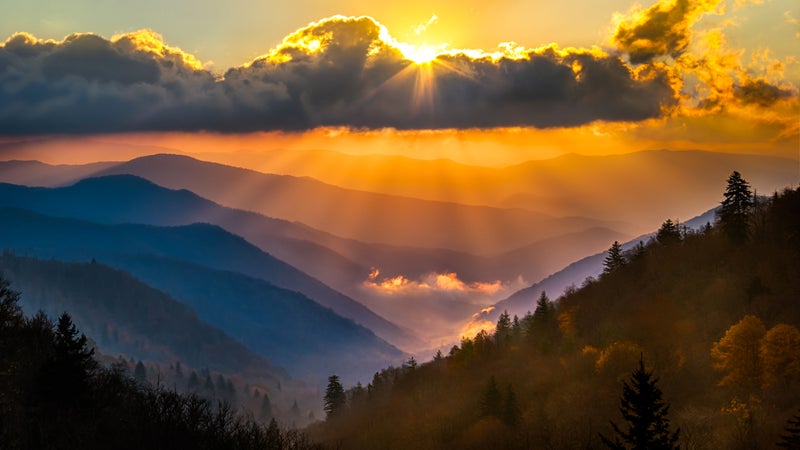
Great Smoky Mountains National Park
North Carolina and Tennessee
Established: 1934
Size: 522,427 acres
Straddling the border of eastern Tennessee and western North Carolina, Great Smoky is easily the most biodiverse national park in the system. Its wide-ranging microclimates are watered by up to 85 inches of rain a year and are rich with Pleistocene-era refugees—animals, plants, and other organisms unique only to this park. In its��fragrant and fertile tangle of wildlands, researchers have discovered 19,000 different species, 1,000 of which haven’t been seen elsewhere in the world, with still more yet to be identified.��With 30 different salamander species, Great Smoky is known to biologists as the salamander capital of the world. To the general public, it’s mostly known for its ancient and smoky-looking mountain range.
The lack of entrance fees, along with the park’s accessibility from large metro areas, allows Smoky to keep winning the national popularity contest. Its 12.5 million visitors in 2019 (twice that of Grand Canyon, the second most popular park) beat the previous year’s record by over a million. On a busy summer day, it can take five hours to drive the traffic-jammed, 11-mile Cades Cove loop through the park’s historic section.
“Park staff numbers are declining as visitation grows, along with wildlife confrontations and collisions,” says Jeff Hunter, a North Carolina–based senior program manager with the ��(NPCA). There are roughly 1,500��black bears in Smoky, mingling with white-tailed deer and elk. Wildlife corridors affording��passage in and out of the park are surrounded by highways. �����ԹϺ��� its��northeast boundary, Interstate 40 is traversed by up to 26,000 cars a day.
In 2015 and 2016, park researchers collared 50 bears and found that the “wild” bears of Great Smoky depended upon a regular city fix: 93 percent of the bruins regularly left park grounds to find food. While garbage is properly contained within its boundaries, bear-proof trash and garbage containers are almost nonexistent in the surrounding towns.��To reach these free pickings, the bears must cross busy highways, and dozens are usually hit and killed on I-40 each year.
As the bears stalk out, ginseng poachers creep in. While the crime of removing these plants from the park is a misdemeanor, at least one repeat offender has served six months in jail. “Nature’s Viagra,” which has been picked since Daniel Boone entered this Appalachia trade more than 230 years ago, generally fetches $800 a pound. Joshua Albritton, a biological-science technician within the park’s resource management division, says he’s noticed that the ginseng “is getting poached out” earlier, before it berries, which is detrimental to the plant’s reproduction. “You used to be able to find plants up to your knees,” says Albritton, “but you just don’t see that any more.”
What you can still see are fantastic views—a big draw for most visitors. From one of 16 rocky summits poking above 6,000 feet, crisscrossed by over 850 miles of trails, hikers can gaze 5,000 feet down over Smoky’s namesake blue haze, caused by trees releasing volatile organic compounds. But the haze is not always natural. According to the recently updated , Great Smoky “experiences some of the highest measured air pollution of any national park in the U.S.”
Twelve streams on the Tennessee side of the park are listed as impaired, due to��high sulfide and nitrogen emissions caused by fossil-fuel burning. Jim Renfro, an air-quality specialist with the park, says that stream restoration would require a 60 percent reduction of the sulfur and nitrogen levels deposited from 2011 to 2014��by the year 2080. “The Clean Air Act is a remarkable success story,”��Renfro adds. “We’re measuring it with real improvements.”
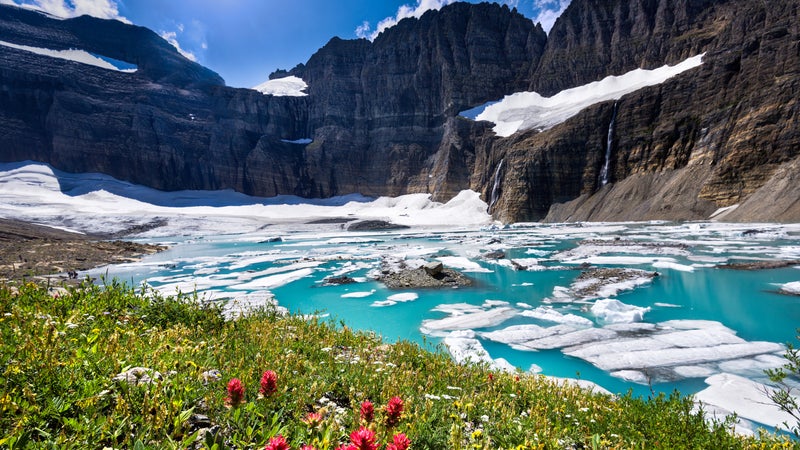
Glacier National Park
Northern Montana
Established:��1910
Size: 1.01 million acres
Out of the seven national parks with an international border, Glacier is the only International Peace Park in the U.S., sharing its boundary with Canada’s . More than just a name, the Peace Park designation refers to collaborative relationships between the two countries to prohibit pollution or development that would affect the��parks on either side.
Glacier National Park was established through the lobbying clout of the Great Northern Railway, which planned to haul millions of tourists to Montana’s Lewis, Clark, and Livingston mountain ranges, known cumulatively as “America’s Switzerland.” But everything changed when national parks had to scramble��to accommodate automobile tourism. In Glacier, it took more than 20��years to design, engineer, and pave the steep 50-mile Going-to-the-Sun Road, with its hairpin turns��up and over the Continental Divide.
Nearly a century later, the exhilarating drive��alongside��huge drop-offs could explain why more than three million visitors traveled to the hinterlands of northern Montana in 2019. Or so could the chance to see one of 300 grizzlies known to roam the park. Then there are the lakes and glaciers. Or, rather, the vanishing glaciers.
Word has gotten out��that if you want to see a real glacier before it’s gone, go now to Glacier.��Ask why they’re shrinking, and even guarded USGS glaciologists who monitor this ice write about human-caused warming as the cause, concluding in a carefully worded that��“the timing of that [land ice] loss��depends on the future trajectory of greenhouse gas emissions.”
According to a of ice loss, certain glaciers will disappear as early as 2030. Since 1966, the glaciers have diminished in size by as much as 85 percent, averaging a 39 percent reduction overall. In 1850, there were 150 glaciers that bulldozed down the valleys here, but since greenhouse gases cranked the temperature up by 2.4 degrees in the park over the past 170 years, today only 26 remain.
Restoration biologist Dawn LaFleur, who arrived in Glacier in 1992, told me that in the nineties��she saw the heavy winter snowpack melting off in late April or May. In summer��it would still snow up high, and the innumerable streams of Glacier roared until winter. But now the snowpack is melting in March, and by August, traditional water sources dry up and the streams go silent.��LaFleur also pulls, mows, or sprays 18 different non-native invasive species��(out of a total 127 invasives in the park) identified in her noxious-weed program. The goal is to maintain native plant communities.
According to a 2017 USGS analysis of ice loss, certain glaciers will disappear as early as 2030.
Glacier is also trying to rescue the white bark pine, a keystone species that many plants and animals depend on for food (pine nuts), shelter, and nesting. Usually found at the edge of the tree line, most of the several-hundred-year-old trees have turned white and skeletal. “About 90 percent of the white bark pine in the park are dead,” LaFleur says.��They were killed by blister rust,��a Eurasian fungus that arrived in contaminated soils in the early 20th century on boats coming to North America.
LaFleur exemplifies the thousands of dedicated park employees who roll up their sleeves and toil to save natural resources. During the winter, she writes grants to raise funds for restoration. In the spring and summer—when not out pulling, mowing, or spraying—she and her colleagues are busy propagating 260 native species in a nursery, including white bark pine that are genetically resistant to blister rust. Since 2000, she has planted 20,000 white bark seedlings, and some of the trees are now seven feet tall. Only one has succumbed to the fungus.
“Another thing that we’re seeing is increased fire activity,” LaFleur says. “Since white bark pine��likes recently burned areas, we plant the seedlings there.”��In a park that “has become the poster child for shrinking glaciers,” she says, she expects that generations ahead of her will carry on with the work of maintaining native plants. “Hopefully we’re not getting to the point where they’ll be functionally lost.”
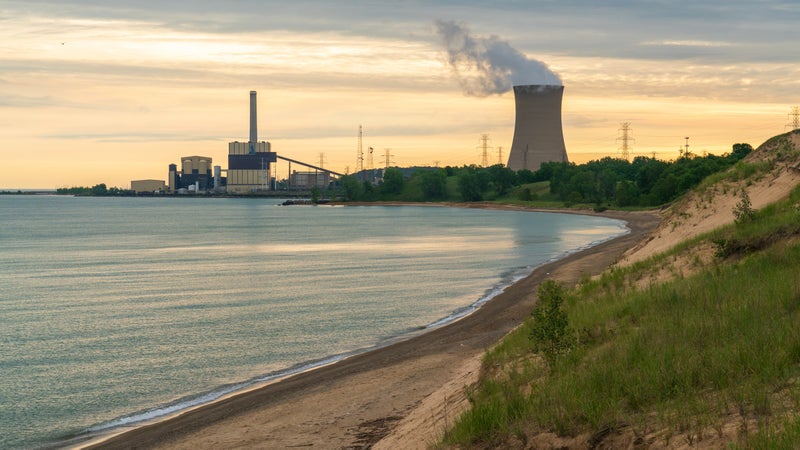
Indiana Dunes National Park
Northern Indiana
Established: 2019
Size: 15,000 acres
On the southern shore of Lake Michigan, this park boasts wetlands, prairies, rivers, and forests, but it’s best known for its giant dunes and surfable waves. For generations, midwesterners from nearby Chicago or South Bend, Indiana, have escaped from the burdens of the steel belt to bask in this protected landscape, watch over 350 species of migrating birds, swim, windsurf, camp, snowshoe, hike 50 miles of trails, or enjoy seeing more than 1,100 different species of plants. The “singing dunes”—under the weight of footsteps, the sand grains vibrate and musically sound off—were first set aside in the system as a national lakeshore in 1966 and became one of the newest national parks in 2019.
At first glance, the southern Lake Michigan beachfront—surrounded by oil refineries, chemical plants, and the Port of Indiana—doesn’t fit the portraiture of America’s best idea. Yet Indiana Dunes is one of several��showing the national park ideal applied to an urban landscape. Its 23 square miles are��now visited by 2.1 million��people a year.
While ornamental invasives were initially planted to beautify areas��outside the park, they have increased in multitudes, killing off native species. The abnormal species include��phragmites, multiflora rose, bush honeysuckle, garlic mustard, and, worst of all, Asiatic bittersweet, a climber that can choke out trees. In many parks, resource management only has the budget to keep up with a fraction of the acreage. In the past, the Park Service here burned off the invaders, sprayed them with chemicals, or dug them out with tractors. More recently, —a lone grazer can devour 300 square feet of invasive buckthorn per day.
But the more pressing problem is industrial pollution. In August 2019, the steel company ��into the Little Calumet River, adjacent to Indiana Dunes. This would eventually kill approximately 3,000 fish, leaving them belly up in Burns Harbor. In December, environmental groups filed a against the company for alleged violations under the Clean Water Act as well as repeated violations of the legislation over the past five years. ArcelorMittal for the spill and, as by the Indiana Department of Environmental Management (IDEM), has sent water samples tested for cyanide and ammonia to��IDEM since August, according to a��. The company did not comment on the pending litigation to�������ԹϺ���.
A year earlier, the Surfrider Foundation and the city of Chicago intervened in the against another neighboring industrial giant, U.S. Steel. In April 2017, the company spilled about��300 pounds of the toxic carcinogen hexavalent chromium (made famous by the Erin Brockovich story in the 1990s) into��Lake Michigan via the Burns Waterway. This was nearly 600 times the discharge allowed under U.S. Steel’s permit. The NPCA filed a in December 2019 protesting the proposed $1.2 million court settlement against U.S. Steel.��Since the company’s earnings could easily pay the fine, the NPCA believed greater constraints were needed to prevent future spills and enforce restoration. The between the U.S. government and U.S. Steel is currently pending before the northernmost district court of Indiana. When reached for comment about the litigation, U.S. Steel directed �����ԹϺ��� to its on the incident, which outlines the company’s response to the spill.
According to Sarah Damron, regional manager of Surfrider, its members , such as skin rashes and urinary-tract infections, after riding at Indiana Dunes.��“Essentially, these spills represent a deterrent from getting in the water,” says��Damron. “No one likes to think that they’re going to cause themselves harm if they get in the water because of what these companies are doing.”
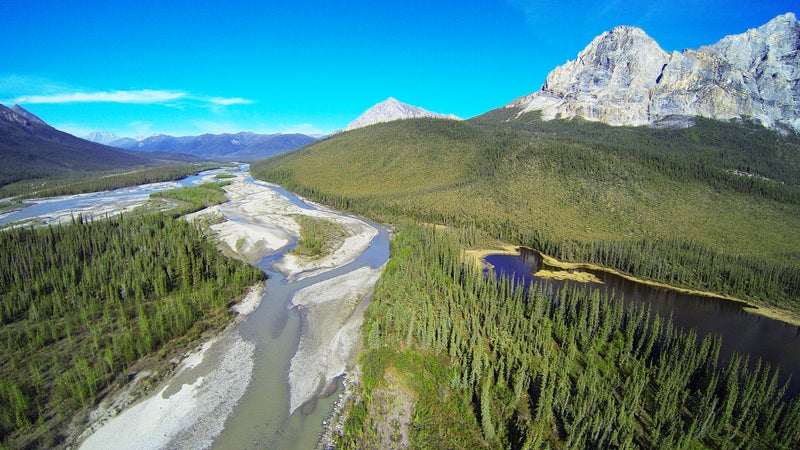
Gates of the Arctic National Park and Preserve
Northern Alaska
Established: 1980
Size: 8.4 million acres��
While national parks in Alaska offer some of the most vast and mind-blowing ecosystems, Gates of the Arctic is the ultimate pristine wilderness. Established through the sweeping Alaska National Interest Lands Conservation Act (ANILCA), Gates of the Arctic National Park and Preserve is the northernmost park in the U.S., with permafrost, rarely climbed mountains, and six Wild and Scenic Rivers.��It’s also the��nation’s second largest park��and mainly accessed by bush plane and��more rarely by hiking in. Combined with the adjoining Noatak National Preserve and Kobuk Valley National Park, this protected land canvases more than 16��million acres.��In 2019, only 10,518 people came to Gates—the least visitation of any national park—to be surrounded by its enormous open spaces and a caribou migration that numbers over 200,000.
It’s not widely known that the parks in northwest Alaska face what Jim Adams, regional director for the state’s NPCA, calls enormous climate-change challenges. The Arctic has warmed faster than any region on earth.��“The tree line is moving north, permafrost is melting, fires are increasing, and ice is preventing the caribou from reaching lichen,”��its food source, Adams says. “The western Arctic caribou herd drives the entire system with a domino effect.”
A keystone species that Adams calls “the heart of the park,” the migratory herd selectively grazes as it passes through, trailed by innumerable predators attacking young or sick members. Yet as warming winters bring abnormal rain, caribou grazing areas are being coated by an impenetrable armor of ice, altering their migration patterns. Lose the caribou—which the poet John Haines called “grey shepherds of the tundra”—and the soul of the region will be irrevocably altered. Nunamiut and Koyukon villagers, wolves, wolverines, foxes, and bears would also face starvation without the herd as a food source. The tundra would become empty.
The park itself is already changing. Rising temperatures lengthen��the growing season for plant life vital to wildlife but also bring��in animals, like landscape-altering beavers,��that��until now��have never inhabited the far north.
“Melting permafrost can catastrophically drain shallow lakes, impacting fish, vegetation, bird habitats, and more,” says biologist Kyle Joly.
Of greater concern, the underlying permafrost, which stretches across 40 million acres of Park Service lands in Alaska, is thawing. As it thins and collapses beneath the surface, trees slump over in what scientists call “drunken forests,” and plant life is often washed away. “Melting permafrost can catastrophically drain shallow lakes, impacting fish, vegetation, bird habitats, and more,” says Kyle Joly, a wildlife biologist at Gates of the Arctic. “It is a big deal that potentially affects many, many things.”
From 2006 to 2009, satellite imaging across the Park Service’s��five Arctic units (Gates, Bering Land Bridge National Preserve, Cape Krusenstern National Monument, Kobuk Valley National Park, and the Noatak National Preserve) nearly 3,000 permafrost anomalies, mostly in Gates and Noatak. Seen from an aircraft, these thermokarst slumps—hollowed-out land produced by melting permafrost—make the tundra appear stripped of its skin,��exposing the white icy bones of our planet as if an autopsy were being performed. One of these slumps in northwestern Gates stretches for 22 acres.
As if Gates isn’t already challenged enough, development continues to come��to the Arctic. Directly south of the park, the Ambler mining district holds some of the richest copper deposits in the world. When Congress created the park, the attached included an easement through the park for a road to access Ambler. After the BLM took public comments, at the end of March it released a final , suggesting a route for a 211-mile gravel road that��would cross over more than a hundred streams—including two Wild and Scenic Rivers—and bisect the caribou migration route, potentially diverting the herd. Acid mine drainage potentially��could run into the Kobuk River. “Common now in Alaska are these hurry-up-and-get-it-done permitting processes,” says��Adams.
Reflecting a minority position in the pro-development state, he hopes that the road and mines will ultimately not be built. Adams calls this untrammeled park “a tremendous opportunity for the people of America to hold on to something that has been lost elsewhere in the country.”
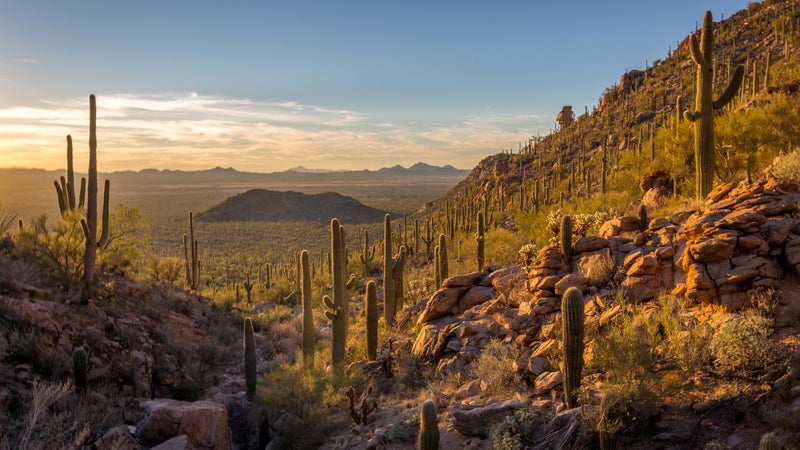
Saguaro National Park
Southern Arizona
Established: 1994
Size: 91,445��acres
Named for its towering cacti, Saguaro lies in the Santa Cruz Valley, 60 miles from the Mexican border, surrounded��by the Sonoran Desert and the burgeoning metropolis of Tucson. The park’s land��is also known for 8,000-year-old anthropological sites and may be the oldest continuously occupied region in North America.
Since the park’s establishment, Tucson��has grown by over 100,000 people. The two separate park districts, called Tucson and Rincon, are attached to the city like earlobes��and are affected by noise and light pollution. Still, Tucsonites are as proud of their saguaro as Northern California is of its redwood. The park forest contains 1.9 million saguaros that can grow up to 70 feet high and are featured as humans��in the creation myths of the local Tohono O’odham Native Americans.
As both a symbol of the desert Southwest and a keystone species that provides shade, nesting sites, and water for numerous plants and animals, the saguaro is now running up against the gauntlet of climate change. Decades of research have shown scientists that the health of this particular forest has waxed and waned throughout wet weather, drought, mining, grazing, and even saguaro poaching.��But , drought and unprecedented heat adversely affected the region, and new saguaro growth drastically slowed.
Around��this time, a��drought-tolerant and noxious weed from Africa called buffel grass took off. Introduced to the region by cattle grazers, buffel grass is one of 11 non-native headaches��for Saguaro National Park managers. The drought-loving grass is so pervasive that it has the potential to change the diverse desert plant life in Saguaro to a monoculture grassland, so��the park has begun spraying and pulling out the invader—but buffel grass is persistent.
It takes the practiced eye of a naturalist or scientist to understand the choke hold that urbanization, climate change, and invasive species have placed on Saguaro. “If we don’t take action now, 50��years from now we’ll be calling it Buffel Grass instead of Saguaro National Park,”��says Kevin Dahl, a local ethnobiologist and the NPCA senior program manager in Arizona. Dahl compares the park’s situation to the life cycle of the saguaro cactus. “Even when they’re dead, they remain upright and look OK. It takes many years for it to change color, die, and fall over.”
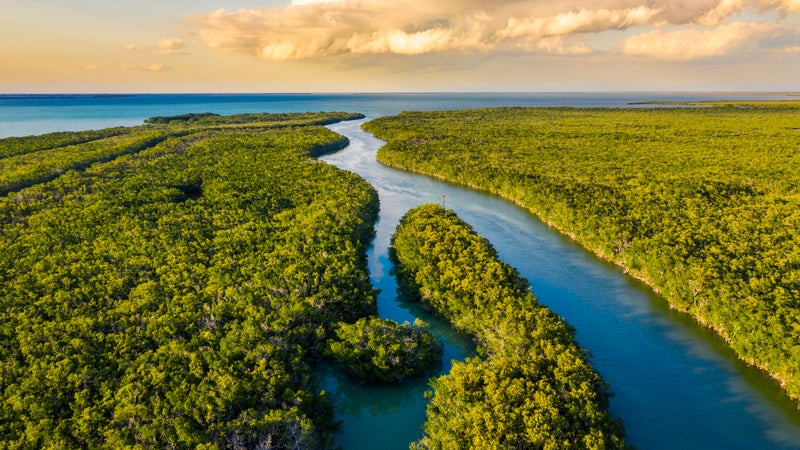
Everglades National Park
Southern Florida
Established: 1947
Size: 1.5 million acres
Everglades was the first national park created mainly��for its biodiversity. The “River of Grass” is the only place in the world where crocodiles hang with alligators alongside one of the greatest collections of wading birds on the continent, all set in the largest subtropical wilderness in the U.S.��The Everglades has a stunning mosaic of nine different habitats, from islands surrounded by mangroves to pine-forested land.
Despite this rich biodiversity, Everglades��is now the most endangered national park of them all. The cause? A lack of fresh water coupled with climate change.
To understand its��problems, it helps to visualize this area as a giant plumbing system. Before modern-day settlements and agriculture arrived, a 60-mile-wide by 100-mile-long river flowed out of the Lake Okeechobee region in central Florida. It ran south, both above and below the state’s��limestone foundation. Over the past 5,000 years, peat accumulated on top of the limestone, which became the springboard for approximately 1,000 plant species, sheltering and feeding more than 360 types of birds, 17 different amphibians, nearly 300 species of fish, about 40 mammals (from panthers to manatees), and only God knows how many insects.
The river that once defined the Everglades used to be held in check—crawling at a quarter-mile per day—by��back pressure from the Atlantic, creating briny estuaries where the ocean,��Gulf of Mexico, and freshwater river met and mingled. But as unprecedented population growth happened along Florida’s coasts, the life-giving river was channelized for flood control. Meanwhile, sugar plantations filled in the marshlands. Storm surges and a rise in ocean waters lapped up and over the Everglades’ mangrove skein, and the diminished river was repeatedly pushed back. “During dry season,” says Steve Davis, a senior ecologist with the Everglades Foundation, “there are often months where there is no freshwater head pushing against the tide.”
Salt water has now overrun freshwater marshes, causing peat soil to collapse,��by one estimate releasing the amount of carbon emitted by 35,000 cars��a year. In the once rich waters of Florida Bay in the southern Everglades, the ocean water has repeatedly turned hypersaline, causing a massive die-off of seagrass��in 2015.
The disintegration of the Everglades continues despite the��$10 billion, 30-year n that Congress signed into law in 2000. The idea was to replenish missing fresh water to support resilience to climate change. An essential part of this plan was to build the $1.7 billion Everglades Reservoir between the park and Lake Okeechobee to store and filter fresh water for the Everglades during dry seasons. But over��the past 20 years, the federal government has not anted up. The work has been tied up in red tape, prolonged studies, and delayed permits. The new estimate has pinned the total cost��at $13.5 billion, with a 50-year completion. In the meantime, saltwater intrusion and peat collapse continue��as a rising ocean and storms breach the coast.��Over the past couple of decades, hurricanes have destroyed two park visitor centers, and the underfunded Park Service is only beginning to rebuild.
There are also invasive species, like Brazilian pepper trees and thousands of voracious Burmese pythons, which displace and gorge upon native plant and animal communities. “Those kinds of things can distract from the overall mission of Everglades restoration,” says Davis. “It’s all about water—getting the right quantity and quality of water back in. And if we can sustain funding, we’re confident that within a decade we can see substantial improvement across the Everglades ecosystem.”
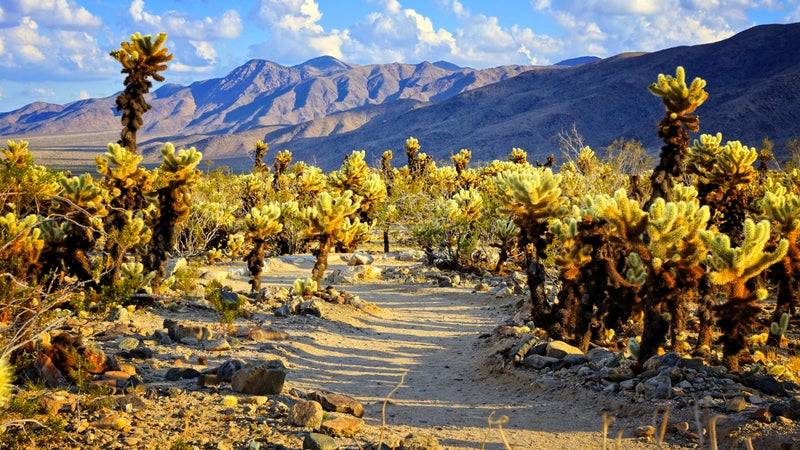
Joshua Tree National Park
Southern California
Established:��1994
Size: 792,623 acres
Joshua Tree is known for sheltering 800 species of plants. Bigger than Rhode Island, the park shares portions of the Mojave and Colorado Deserts. It’s also a Southern California mecca for winter rock climbers, with three-story��granite boulders set amid��a landscape of dunes, low basins, and high mountains pocketed by stands of yuccas mistaken for trees. Named by emigrating Mormons, the branches of these plants appear to be reaching out to the sky, like the biblical Joshua beseeching the Lord.
In the 1920s, when conservationist and noted gardener Minerva Hoyt first started lobbying Presidents Hoover and Roosevelt to protect this region, she wanted to call it Desert Plants Park. Hoyt was dismayed by��roads being built nearby and the theft of cacti and other plants poached for Los Angeles lawns.
Today, Joshua Tree’s namesake species may soon fall under the climate-change ax. In the past 40 years, nighttime temperatures have risen by nearly eight degrees,��increasing evaporation and pulling water from the plants.
Twenty-seven micro plots were set up throughout the park in 2014 so that researchers could advise park managers of the most vulnerable species to the heat. Joining the beleaguered list are the yucca night lizard, which lives��under the branches of the tree,��pinion pine,��manzanita,��bighorn sheep,��and the desert tortoise.
What might be the fate of these vulnerable species 50 years from now? “I’d like to be optimistic,” says University of California at Riverside plant ecologist Lynn Sweet, one of the lead researchers working with the park. “If we do nothing and reduce no carbons, we’ll see no Joshua trees in the park. As a planet, if we lower emissions as per IPCC [Intergovernmental Panel on Climate Change] standards, maybe we’ll save 20 percent of the�������ٲ���.”
Rising temperatures aren’t the only challenge. Joshua Tree is one of several California national parks suffering from some of��the , which deposits��nitrogen that fertilizes invasive, drought-tolerant species that outcompete native plants already adapted to low-nitrogen soils. The western edge of the park has now exceeded what scientists refer to as a “critical load” of nitrogen.
For vulnerable park wildlife, the loss of native plants will equal a loss of shelter, nesting sites, and food. As for visitors, when the hot days cause the worst pollution, expect the normal 100-mile views to be cut in half. The air is already unhealthly to breathe here two months of the year, but��if provisions that protect parks—such as the Regional Haze Rule—within the Clean Air Act are rolled back, consider keeping those COVID-19 masks on year-round.
How You Can Help��
- Avoid traveling to the most crowded parks at peak times in the summer: Great Smoky Mountains, Grand Canyon, Rocky Mountain, Zion, Yosemite, Yellowstone, Acadia, Grand Teton, Olympic,��and Glacier.
- Support the parks by donating to the .
- Contact your congressional representatives and ask them to fully fund the annual national park budget that would increase staffing and resource protection.


